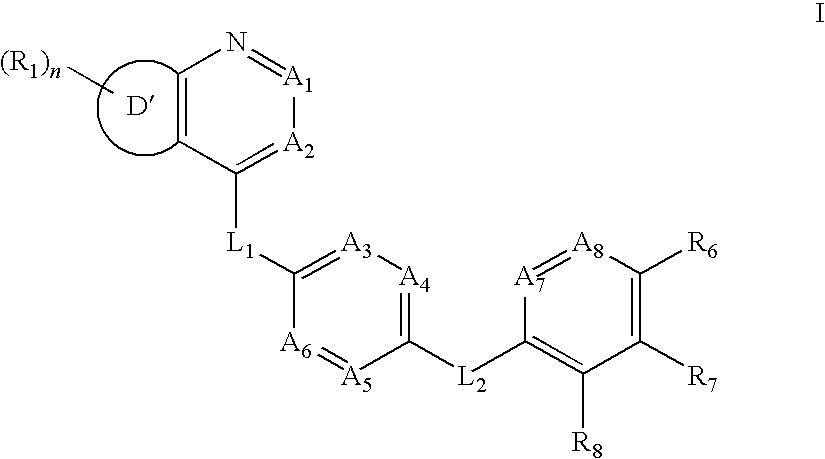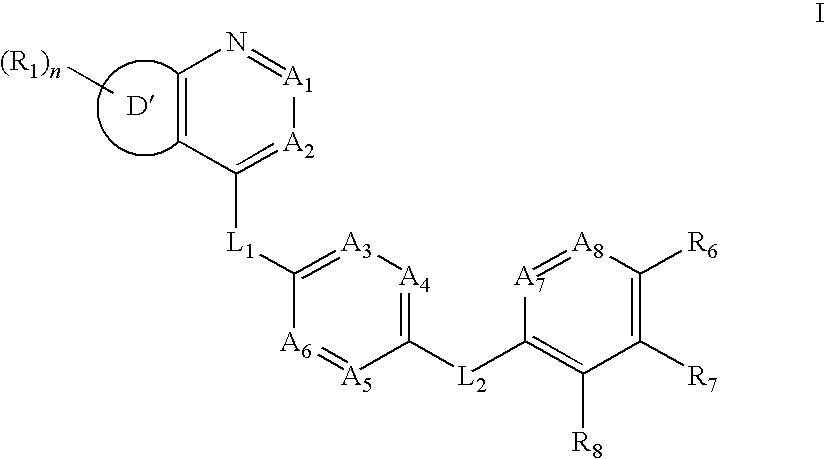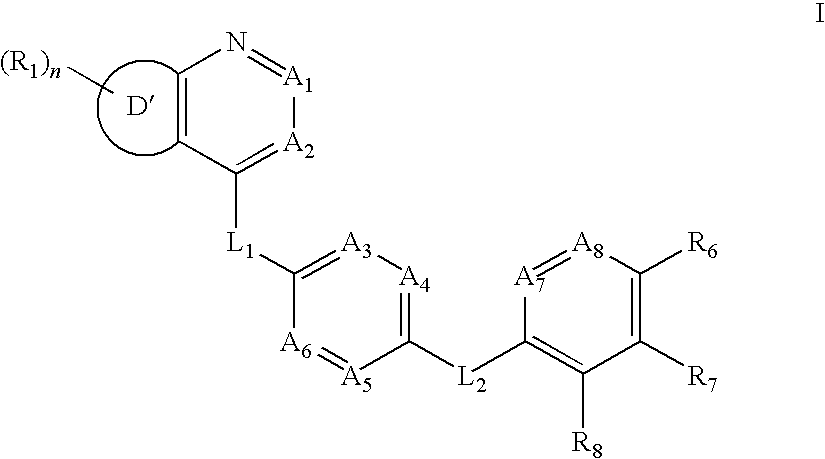Aurora kinase modulators and method of use
a kinase and aurora technology, applied in the field of aurora kinase modulators and methods of use, can solve the problems of affecting mankind and a major cause of death worldwide, few offer any considerable degree of success, and loss of normal cell proliferation regulation
- Summary
- Abstract
- Description
- Claims
- Application Information
AI Technical Summary
Benefits of technology
Problems solved by technology
Method used
Image
Examples
example 1
[0363]
Synthesis of 3-bromo-8-chloro-1,5-naphthyridine
Step 1: Diethyl 2-((5-bromonyridin-3-ylamino)methylene)malonate
[0364]To a 500 mL RBF containing 5-bromopyridin-3-amine (60.0 g, 347 mmol) was added diethyl 2-(ethoxymethylene)malonate (71.0 mL, 354 mmol) and 121 mL of toluene. The reaction mixture was heated to reflux for 3 h. The reaction mixture was allowed to cool RT overnight, and the resulting precipitate was collected by filtration and dried to give the desired product as a white crystalline solid.
Step 2: Ethyl 7-bromo-4-oxo-1,4-dihydro-1,5-naphthyridine-3-carboxylate
[0365]In a RBF fitted with a reflux condenser a mixture of diethyl 2-((5-bromopyridin-3-ylamino)methylene)malonate (1 g, 3 mmol) and 1-phenoxybenzene (10 mL, 63 mmol) was heated to reflux for 1 h. The reaction mixture was allowed to cool to RT and CH3CN was added. The resulting solids were filtered and dried to provide the desired product as a light brown solid.
Step 3: 7-bromo-4-hydroxy-1,5-naphthyridine-3-carbo...
example 2
[0369]
Synthesis of 7-Methoxy-1H-[1,6]naphthyridin-4-one
Step 1: 4-amino-3-bromo-2-chloropyridine
[0370]4-Amino-2-chloropyridine (50 g, 388 mmol) was dissolved in glacial acetic acid (500 mL). To this solution was added NBS (75 g, 426 mmol) portionwise at RT (water bath cooling was provided to control the exothermicity). The reaction mixture was stirred at RT for 1 h at which point the reaction was found complete (as monitored by TLC). Solvent was removed under reduced pressure followed by azeotropic distillation with ethanol. The crude product was purified by column chromatography on silica gel (230-400 mesh) eluting with ethyl acetate hexane mixture.
Step 2: 4-amino-3-bromo-2-methoxypyridine
[0371]Methanol (350 mL) was charged in a two-neck RBF equipped with a guard tube and septum and cooled to 0° C. Sodium metal (23 g) was added to it slowly in pieces. After all sodium metal had dissolved, 4-amino-3-bromo-2-chloro pyridine (23 g, 178 mmol) was added and the solution was heated at 180...
example 3
[0376]
Synthesis of 8-chloro-3-methoxy-1,5-naphthyridine
Step 1: 3-Bromo-5-methoxypyridine
[0377]Sodium (12 g) was dissolved in methanol (150 mL) while cooling, and excess MeOH was removed under reduced pressure to obtain NaOMe, which was azeotroped with toluene (2×100 mL). A solution of 3,5-dibromopyridine (100 g) in DMSO (500 mL) was added to sodium methoxide and the mixture was stirred at 90° C. for 2 h. After cooling to RT, aqueous NaOH solution (3 M, 300 mL) was added and the mixture was extracted with Et2O. The ethereal layer was washed with brine and dried over Na2SO4. After concentration the crude product obtained was purified by flash column chromatography (Hexane:EtOAc 85:15) to afford pure product 3-bromo-5-methoxy pyidine.
Step 2: 3-amino-5-methoxypyridine
[0378]3-Bromo-5-methoxypyridine (15 g) was added to a pressure vessel, and CuSO4(3.9 g) and 25% aq. ammonia (150 mL) were added. The reaction mixture was stirred for 4 h at 135° C., then cooled to RT, basified with aqueous ...
PUM
| Property | Measurement | Unit |
|---|---|---|
| flow rate | aaaaa | aaaaa |
| flow rate | aaaaa | aaaaa |
| time | aaaaa | aaaaa |
Abstract
Description
Claims
Application Information
 Login to View More
Login to View More - R&D
- Intellectual Property
- Life Sciences
- Materials
- Tech Scout
- Unparalleled Data Quality
- Higher Quality Content
- 60% Fewer Hallucinations
Browse by: Latest US Patents, China's latest patents, Technical Efficacy Thesaurus, Application Domain, Technology Topic, Popular Technical Reports.
© 2025 PatSnap. All rights reserved.Legal|Privacy policy|Modern Slavery Act Transparency Statement|Sitemap|About US| Contact US: help@patsnap.com



